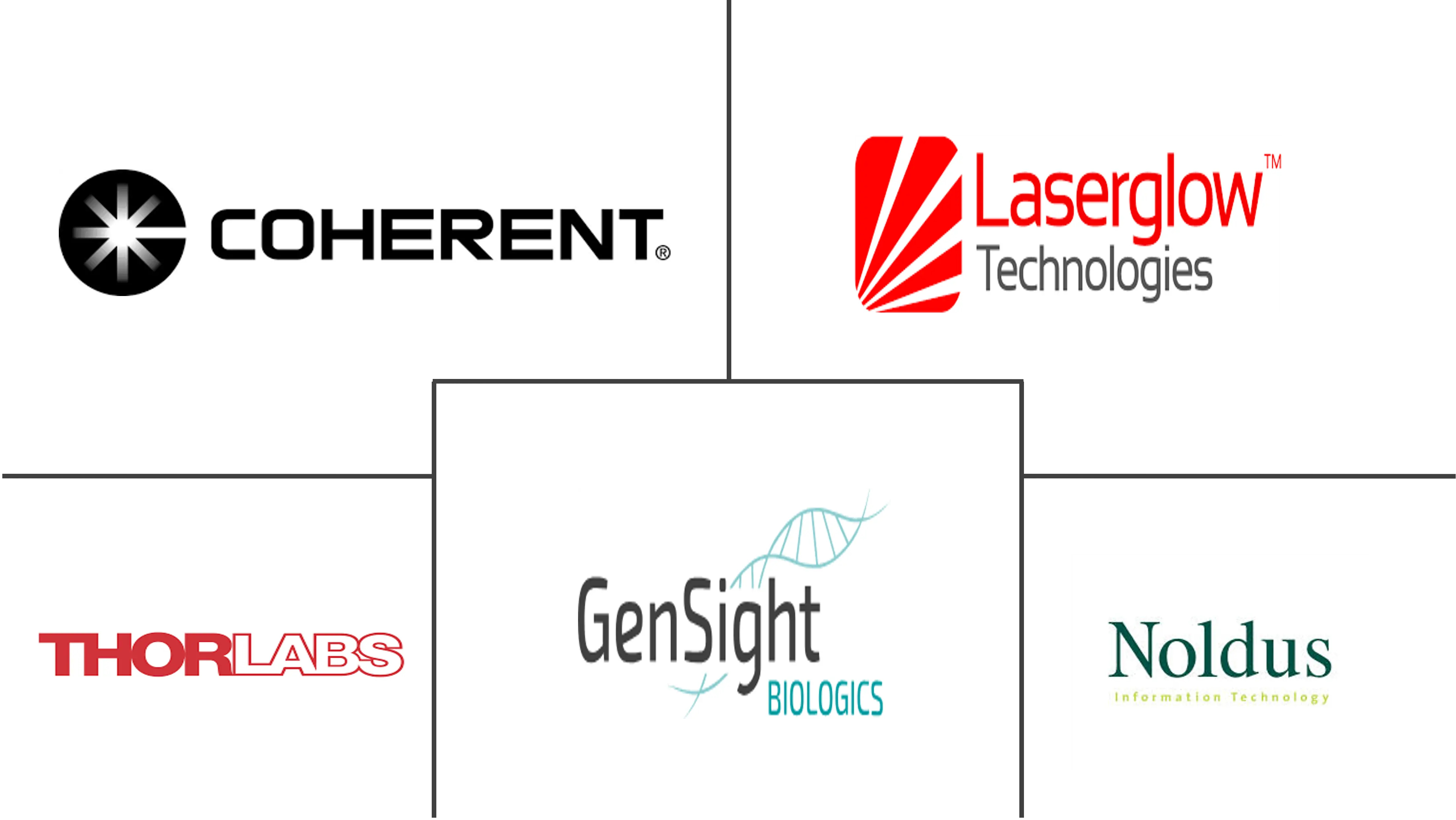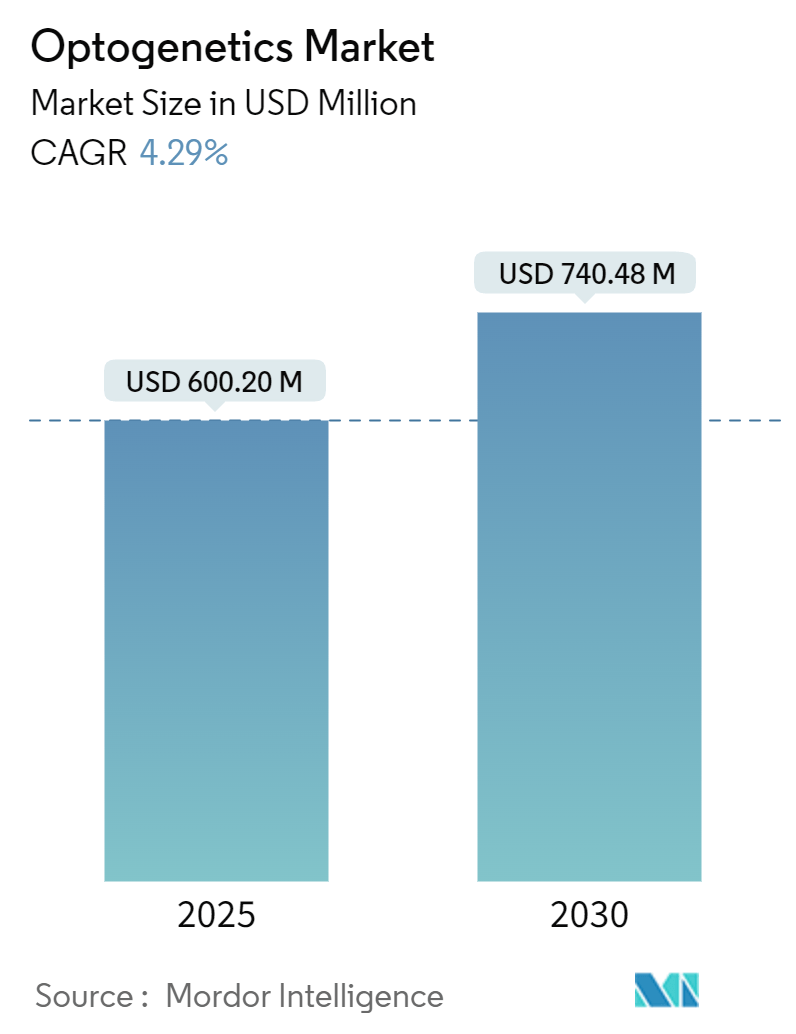
Optogenetics Market Analysis
The Optogenetics Market size is estimated at USD 600.20 million in 2025, and is expected to reach USD 740.48 million by 2030, at a CAGR of 4.29% during the forecast period (2025-2030).
The optogenetics industry has undergone significant transformation since its inception, evolving from a specialized research tool to a revolutionary technology with broad applications across neuroscience and medical research. The field has witnessed remarkable technological advancements in light delivery systems, genetic engineering techniques, and precision targeting capabilities. These developments have enabled researchers to achieve unprecedented control over neural circuits with exceptional temporal and spatial resolution. The integration of optogenetic technology with other cutting-edge technologies has expanded its utility beyond traditional applications, creating new possibilities for understanding and treating neurological conditions.
The growing burden of neurological disorders has intensified the focus on optogenetics as a therapeutic approach. According to recent scientific reports from October 2022, the cumulative prevalence of Parkinson's disease in Sweden reached 54% over the past decade, highlighting the urgent need for innovative treatment approaches. The technology's ability to precisely manipulate neural circuits has made it particularly valuable in studying and potentially treating conditions such as depression, obsessive-compulsive disorders, and various neurodegenerative diseases. The increasing sophistication of optogenetic technology has enabled researchers to target specific neural pathways with greater accuracy, leading to more effective therapeutic strategies.
Strategic partnerships and collaborations have emerged as key drivers of innovation in the optogenetics market. In September 2021, a significant partnership between TSE Systems and NeuroLux demonstrated the industry's move toward integrated solutions, combining advanced preclinical research equipment with battery-free wireless optogenetics implants. This trend of collaborative development has accelerated the pace of technological advancement, leading to more sophisticated and user-friendly optogenetic tools. Research institutions and commercial entities are increasingly working together to develop standardized protocols and improve the accessibility of optogenetic technology.
The field is witnessing expansion into new therapeutic areas beyond traditional neuroscience applications. Researchers are exploring applications in cardiac optogenetics, vision restoration, and other physiological systems, demonstrating the versatility of this technology platform. The development of novel opsins and improved light delivery systems continues to open new possibilities for clinical applications. The industry is increasingly focusing on miniaturization and wireless capabilities, making optogenetic interventions more practical for clinical settings. These advancements are paving the way for potential therapeutic applications in previously untreatable conditions, while maintaining high standards of precision and safety.
Optogenetics Market Trends
Potential Diagnostic Tool in the Field of Neurosciences
Optogenetics has emerged as a revolutionary diagnostic tool in neuroscience research, offering unprecedented precision in controlling and monitoring neural activity. The technology enables researchers to control specific neurons in experimental subjects, providing crucial insights into brain pathways involved in various neurological conditions, including depression, obsessive-compulsive disorder, and Parkinson's disease. The precision of optogenetics holds particular promise for improved normalization of circuits that are dysfunctional in Parkinson's disease and its diagnosis, while the use of light rather than electricity reduces the risk of unintended effects caused by non-specific influences.
The growing adoption of optogenetic technology in neuroscience research is supported by substantial increases in research funding. The National Institutes of Health (NIH) has demonstrated a strong commitment to neuroscience research, with total neurosciences funding increasing from USD 5,340 million in 2013 to an estimated USD 10,323 million by 2021, representing a significant investment in advancing neurological research capabilities. This continuous increase in research investment is driving innovations in optogenetic applications, particularly in the study and treatment of conditions such as epilepsy, where the technology offers new avenues for investigating dekindling and the gradual decrease in seizure propensity.
Rapid Growth of Advanced Technology
The field of optogenetics has significantly benefited from rapid technological advancements across multiple domains, including laser and LED technology, higher-performance computing, graphics processing units (GPUs), cloud computing, and genetic advances. Recent innovations in laser technology have particularly enhanced research capabilities, with developments in wavelength optimization and delivery methods improving the precision and effectiveness of optogenetic technology applications. The evolution from traditional titanium sapphire lasers to more advanced options, such as lasers with ytterbium-doped gain materials, has expanded the power and wavelength range available for optogenetic research.
Significant technological breakthroughs have emerged in light delivery systems, particularly in the development of tapered optical fibers. These advanced fibers can now deliver light to depths of more than 1 mm in the living brain while remaining minimally invasive, representing a substantial improvement over conventional delivery systems. The development of new approaches for wavelength optimization has also enhanced the field, with researchers comparing blue and red light applications to determine optimal conditions for neurological disease diagnosis and treatment. Red light, with wavelengths of 630-710 nm, demonstrates superior tissue penetration compared to blue light (430-500 nm), enabling more effective deep-tissue applications.
Increasing Use of Multimodal Imaging
Multimodal imaging has become increasingly central to advancing optogenetic applications, combining multiple imaging techniques to enhance disease detection and localization capabilities. The integration of various imaging modalities, such as second-harmonic and third-harmonic generation into unified systems, has significantly improved the ability to observe and analyze neural activity. This approach allows researchers to simultaneously produce signals for multiple imaging techniques, including optical, magnetic, and radioactive reporters, leading to more comprehensive and accurate disease detection and localization.
The advancement of multimodal molecular imaging has demonstrated particular value in improving outcomes across various clinical applications. This technology has proven especially beneficial in the treatment of cardiovascular diseases, neuropsychiatric conditions, and other clinical disorders. In tumor-related applications, multimodal imaging has enhanced the precision of tumor border positioning and surgical resection guidance. The technology's ability to provide label-free imaging through endogenous fluorescence offers significant advantages over traditional fluorescent-labeled proteins, as natural signals, though sparse and weak, present less potential harm to biological systems.
Segment Analysis: By Light Equipment
Laser Segment in Optogenetics Market
The laser segment continues to dominate the global optogenetics market, commanding approximately 50% of the market share in 2024. This significant market position is attributed to the widespread adoption of lasers in multiple contexts, including ophthalmology and neuroscience research, primarily due to their compact, easy-to-use, and self-contained modules. Lasers offer various wavelengths and pulse durations, providing researchers with precise control over neural activity patterns. The segment's prominence is further strengthened by its ability to deliver targeted stimulation at specific wavelengths, making it particularly effective for optogenetic applications in deep brain regions. The versatility of laser technology in offering different wavelengths and pulse durations has made it an indispensable tool in optogenetics research, particularly in applications requiring high spatial and temporal precision.
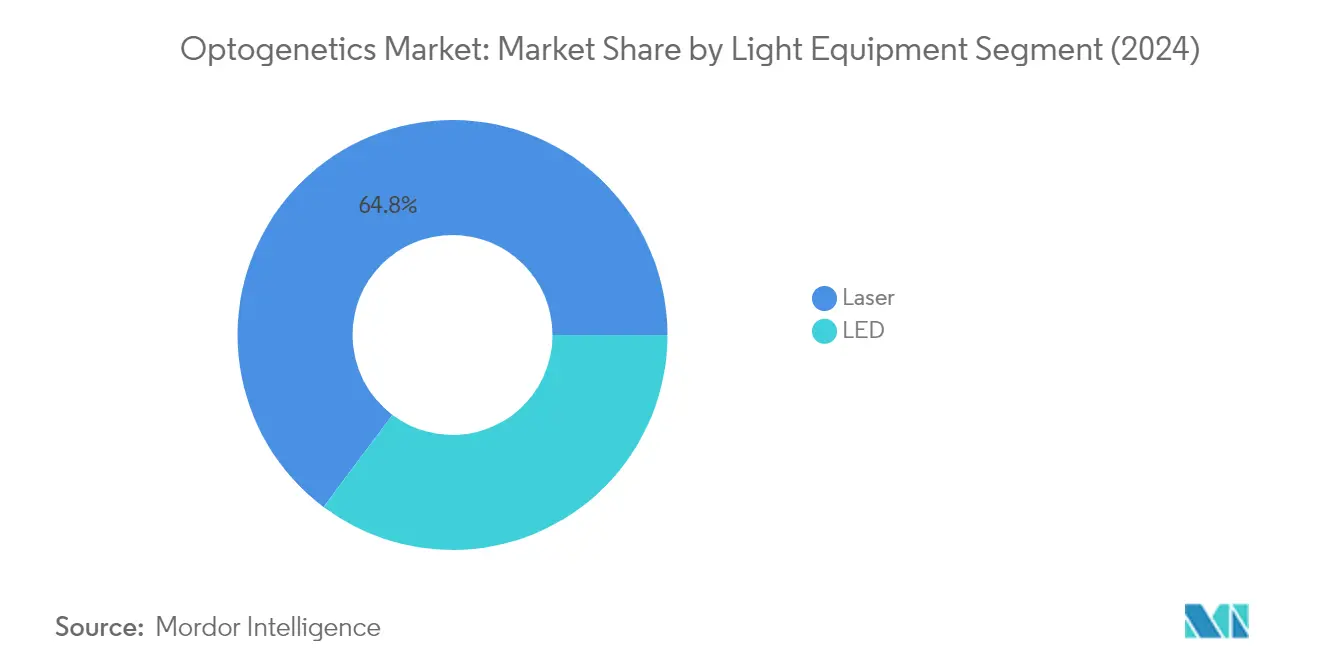
LED Segment in Optogenetics Market
The Light-emitting Diode (LED) segment is emerging as the fastest-growing segment in the optogenetics market, projected to grow at approximately 4% CAGR from 2024 to 2029. This growth trajectory is driven by several advantageous characteristics of LED technology, including low cost, long lifetime, high flexibility, and low electric power consumption. The increasing adoption of LED technology is particularly notable in applications requiring conformable attachment to soft neuronal tissues such as peripheral nerves or the brain. LEDs are becoming increasingly popular in optogenetics research due to their compatibility with neuroimaging techniques like Magnetic Resonance Imaging (MRI), which allows researchers to investigate evoked activities in the whole brain. The segment's growth is further supported by technological advancements in LED design and manufacturing, making them more efficient and suitable for various optogenetic applications.
Segment Analysis: By Actuator
Channelrhodopsin Segment in Optogenetics Market
The Channelrhodopsin segment continues to dominate the global optogenetics market, commanding approximately 45% of the total market share in 2024. This significant market position can be attributed to Channelrhodopsin's crucial role as a light-gated ion channel that enables fast depolarization of neurons when exposed to light through direct stimulation. The segment's prominence is further strengthened by its widespread adoption in neuroscience research, particularly in studying circuit functions in the brain. Channelrhodopsin-2 (ChR2) has emerged as the most widely adopted optogenetic tool, preferred over ChR1 due to its high affinity for life pH and superior membrane migration properties. The development of engineered Channelrhodopsin variants has also contributed to its market leadership, as these variants demonstrate promising results in terms of highest photocurrents and efficient inactivation with coillumination.
Archaerhodopsin Segment in Optogenetics Market
The Archaerhodopsin segment is projected to exhibit the highest growth rate of approximately 5% during the forecast period 2024-2029. This accelerated growth is driven by the segment's unique capabilities in neuronal inhibition through light-activated outward proton pumping mechanisms. The increasing adoption of Archaerhodopsin in optogenetic experiments, particularly for prolonged silencing of neurons, is fueling this growth trajectory. Research developments focusing on the effectiveness of different wavelengths of light in activating Archaerhodopsin for extended neuronal silencing have opened new possibilities in neuroscience research. The segment's growth is further supported by advancements in developing engineered Arch variants, which enable researchers to better analyze physiological responses in targeted biological systems.
Remaining Segments in Optogenetics Actuator Market
The Halorhodopsin segment represents another crucial component of the optogenetics actuator market, offering distinct capabilities in neuronal inhibition through light-gated inward chloride pumps. This segment plays a vital role in inhibiting cell function, particularly through the widely used NpHR variant isolated from Natronomonas pharaonic. The technology's ability to achieve finely-tuned control of membrane polarization and its effectiveness in prolonged silencing of action potentials has established its importance in optogenetic applications. The development of enhanced versions like eNpHR3.0 has further strengthened this segment's position in the market by enabling more stable and efficient neuronal inhibition.
Segment Analysis: By Sensor
Calcium Sensors Segment in Optogenetics Market
The Calcium sensors segment, which includes Aequorin, Cameleon, and other calcium sensors, maintains its dominant position in the optogenetics market, commanding approximately 31% of the market share in 2024. This segment's leadership is primarily driven by the widespread adoption of genetically encoded calcium indicators (GECI) in neuroscience research, where they serve as the most commonly applied fluorescent sensors. The segment's prominence is further strengthened by its crucial role in studying dysfunctional calcium signaling in a cell type-specific manner, particularly in applications related to renal hypertension research. The development of novel nuclear-targeted versions of Foster resonance energy transfer (FRET)-based Ca2+ probes has expanded the capabilities of calcium sensors, enabling simultaneous monitoring of nuclear and organelle calcium signaling in response to various cell stimuli.
Chloride Sensors Segment in Optogenetics Market
The Chloride sensors segment, primarily represented by Clomeleon technology, is projected to exhibit the highest growth rate of approximately 5% during the forecast period 2024-2029. This remarkable growth is attributed to its essential role in optogenetic imaging of inhibitory circuit activity, where Clomeleon offers unique capabilities in imaging synaptic inhibition. The segment's expansion is driven by its ability to process information through transmembrane fluxes of Cl- through GABA and glycine receptors, making it invaluable for neural network studies. The FRET-based Cl- indicator's capability to be excited by visible light has made it the preferred choice for inhibitory sensing in optogenetics applications, particularly in studying odor-evoked inhibition patterns in sensory neurons and second-order projection neurons.
Remaining Segments in Optogenetics Sensor Market
The Membrane-gated (Mermaid) sensors and Other Sensors segments continue to play vital roles in the optogenetics market landscape. Mermaid sensors, functioning as voltage-sensitive fluorescent proteins (VSFP), offer direct observation capabilities for membrane potential changes and are particularly valuable in zebrafish heart and mouse somatosensory cortex studies. The Other Sensors category, encompassing glutamate-sensitive fluorescent reporters and synapto-pHluorin, provides essential tools for monitoring vesicle release and recycling in neuroscience applications. These segments contribute significantly to the market's diversity by offering specialized solutions for specific research applications, particularly in studying transmitter release and cellular functions in neural tissues.
Segment Analysis: By Application
Neuroscience Segment in Optogenetics Market
The Neuroscience segment continues to dominate the global optogenetics market, commanding approximately 51% of the total market share in 2024. This significant market position is driven by the increasing prevalence of neurological disorders worldwide and the growing adoption of optogenetic technology in neuroscience research. The segment's prominence is further strengthened by substantial research funding in neuroscience, particularly for studying conditions like Parkinson's disease, Alzheimer's, and other neurodegenerative disorders. The application of optogenetics in neuroscience has revolutionized researchers' ability to understand neural circuits and brain function, enabling precise control and manipulation of specific neurons using light. Advanced research facilities and academic institutions are increasingly incorporating optogenetic technology for studying neural pathways and developing potential treatments for neurological conditions.
Retinal Disease Treatment Segment in Optogenetics Market
The Retinal Disease Treatment segment is emerging as the fastest-growing application area in the optogenetics market, projected to experience robust growth from 2024 to 2029. This segment's rapid expansion is primarily driven by the increasing prevalence of retinal disorders and the promising potential of optogenetics in treating conditions like retinitis pigmentosa and macular degeneration. The advancement in optogenetic techniques has opened new possibilities for restoring vision in patients with various genetic defects and diabetic retinopathy. Research institutions and biotechnology companies are actively investing in developing innovative optogenetic therapies for vision restoration, contributing to the segment's growth. The integration of optogenetics with other cutting-edge technologies and the successful outcomes of clinical trials are further accelerating the adoption of these treatments in ophthalmology.
Remaining Segments in Optogenetics Market by Application
The Behavioral Tracking and Other Applications segments also play crucial roles in the optogenetics market landscape. Behavioral Tracking applications have gained significant traction in studying complex behaviors and mental health conditions, offering researchers powerful tools to understand neural circuits involved in various behavioral patterns. This segment has become particularly valuable in research related to addiction, depression, and anxiety disorders. The Other Applications segment encompasses emerging areas such as cardiac optogenetics and hearing impairment research, demonstrating the versatility of optogenetic techniques beyond traditional applications. These segments continue to evolve with new research discoveries and technological advancements, contributing to the overall growth and diversification of the optogenetics market.
Optogenetics Market Geography Segment Analysis
Optogenetics Market in North America
North America represents a dominant force in the global optogenetics market, driven by advanced healthcare infrastructure and substantial research activities. The United States, Canada, and Mexico comprise the key markets in this region, with each country contributing uniquely to the market's development. The presence of major research institutions, increasing government funding for neuroscience research, and growing adoption of advanced technologies in healthcare facilities have positioned North America as a leader in optogenetics innovation and implementation.
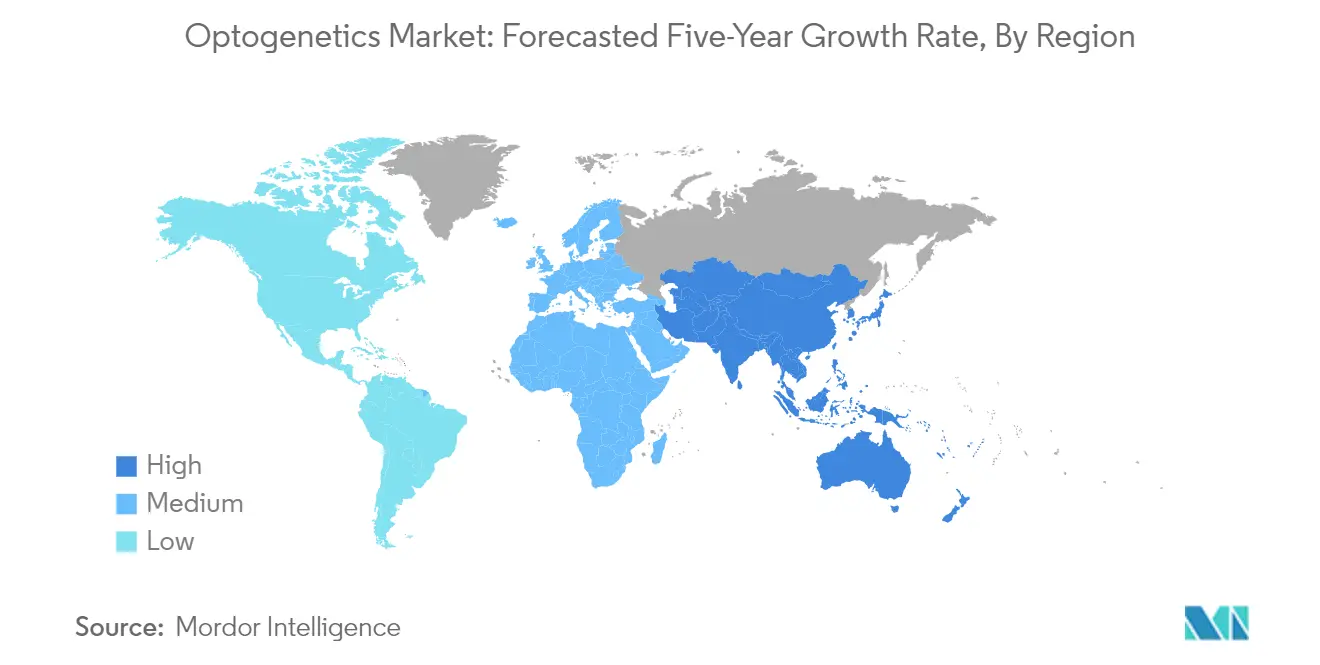
Optogenetics Market in the United States
The United States maintains its position as the largest market for optogenetics in North America, holding approximately 78% of the regional market share in 2024. The country's dominance is attributed to its robust healthcare system, significant investments in research and development, and the presence of leading biotechnology companies. The National Institutes of Health's continued support for neuroscience research, coupled with the presence of numerous academic institutions actively engaged in optogenetics research, has created a favorable environment for market growth. The country's advanced technological infrastructure and strong focus on innovative therapeutic approaches have made it a hub for optogenetic technology research and development.
Growth Dynamics in the United States Optogenetics Market
The United States is also experiencing the highest growth rate in the North American region, with a projected CAGR of approximately 3% during 2024-2029. This growth is driven by increasing research activities in neuroscience, rising prevalence of neurological disorders, and growing adoption of optogenetics in various therapeutic applications. The country's commitment to advancing neurological research, combined with substantial private sector investments and technological innovations, continues to fuel market expansion. The presence of well-established research facilities and ongoing clinical trials further supports this growth trajectory.
Optogenetics Market in Europe
Europe represents a significant market for optogenetics, characterized by strong research infrastructure and increasing investments in neuroscience research. The region's market is primarily driven by countries including Germany, the United Kingdom, France, Italy, and Spain. The presence of renowned research institutions, growing government support for neuroscience research, and increasing collaboration between academic and industrial sectors have contributed to the region's market development. The European market benefits from advanced healthcare systems and a strong focus on innovative therapeutic approaches.
Optogenetics Market in Germany
Germany emerges as the largest optogenetics market in Europe, commanding approximately 22% of the regional market share in 2024. The country's leadership position is supported by its advanced healthcare infrastructure, strong research capabilities, and significant investments in neuroscience research. German research institutions and universities have been at the forefront of optogenetics innovation, with numerous ongoing research projects and clinical trials. The country's robust pharmaceutical and biotechnology sectors, combined with substantial government support for research activities, have created a conducive environment for market growth.
Growth Dynamics in the German Optogenetics Market
Germany also leads the European region in terms of growth rate, with a projected CAGR of approximately 4% during 2024-2029. This growth is driven by increasing research activities, rising prevalence of neurological disorders, and growing adoption of advanced therapeutic technologies. The country's strong focus on research and development, coupled with collaborations between academic institutions and industry players, continues to drive innovation in the field. Germany's commitment to advancing medical research and its well-established healthcare system further support this growth trajectory.
Optogenetics Market in Asia-Pacific
The Asia-Pacific region represents a rapidly evolving market for optogenetics, characterized by increasing research activities and growing investments in healthcare infrastructure. The region encompasses key markets including China, Japan, India, Australia, and South Korea. The market is driven by rising awareness about neurological disorders, improving healthcare infrastructure, and growing government support for research activities. The presence of a large patient pool and increasing adoption of advanced medical technologies contribute to the region's market dynamics.
Optogenetics Market in China
China stands as the largest optogenetics market in the Asia-Pacific region. The country's dominant position is attributed to its large population base, increasing healthcare expenditure, and growing focus on research and development activities. Chinese research institutions have been actively involved in optogenetics research, particularly in exploring its applications in traditional Chinese medicine and modern neuroscience. The country's substantial investments in healthcare infrastructure and research facilities have created a strong foundation for market growth.
Growth Dynamics in the Indian Optogenetics Market
India emerges as the fastest-growing market in the Asia-Pacific region. The country's growth is driven by increasing research activities in neuroscience, rising prevalence of neurological disorders, and growing adoption of advanced medical technologies. The presence of numerous research institutes and universities focusing on neurological research, coupled with government initiatives to promote scientific research, contributes to market expansion. India's developing healthcare infrastructure and growing focus on innovative therapeutic approaches further support this growth trajectory.
Optogenetics Market in Middle East & Africa
The Middle East & Africa region presents an emerging market for optogenetics, with growing potential in research and clinical applications. The market encompasses key regions including GCC countries and South Africa. The GCC region leads both in terms of market size and growth rate, driven by substantial healthcare investments and improving research infrastructure. The region's market development is supported by increasing awareness about neurological disorders and growing adoption of advanced medical technologies, particularly in major healthcare centers across GCC countries and South Africa.
Optogenetics Market in South America
South America represents an evolving market for optogenetics, with Brazil and Argentina as key contributing countries. Brazil emerges as both the largest and fastest-growing market in the region, supported by its extensive healthcare infrastructure and increasing research activities. The region's market is characterized by growing investments in healthcare research, rising awareness about neurological disorders, and improving access to advanced medical technologies. The presence of research institutions and increasing government support for scientific research contribute to the market's development across South American countries.
Optogenetics Industry Overview
Top Companies in Optogenetics Market
The optogenetics market features prominent players like Thorlabs, Coherent Inc., Bruker Corporation, GenSight Biologics, Laserglow Technologies, and Judges Scientific among others. These optogenetics companies are heavily investing in research and development to advance optogenetic technology, particularly focusing on developing improved light delivery systems and novel opsins. Strategic collaborations with research institutions and academic centers have become increasingly common to accelerate innovation and expand application areas. Companies are also emphasizing vertical integration to strengthen their market position, with many players developing comprehensive solution portfolios spanning light equipment, actuators, and sensors. Geographic expansion, particularly in emerging markets, coupled with continuous product launches and technological upgrades, remains a key focus area for market leaders.
Moderate Consolidation with Strong Research Focus
The optogenetics market exhibits a moderate level of consolidation, characterized by a mix of large scientific instrument manufacturers and specialized biotechnology companies. The market structure is unique as it includes both profit-driven corporations and non-profit research institutions actively contributing to technology development. While global players dominate the light equipment segment with their established distribution networks and technological capabilities, the actuators and sensors market features more specialized players focused on specific applications and research areas.
The industry has witnessed strategic acquisitions aimed at expanding technological capabilities and market reach, exemplified by moves like Novartis's acquisition of Arctos Medical and Vedere Bio to strengthen their optogenetics portfolio. Market participants are increasingly forming partnerships with academic institutions and research centers, creating a collaborative ecosystem that drives innovation while maintaining competitive advantages. This hybrid competitive landscape, combining commercial and research interests, has created unique dynamics where success depends on both scientific advancement and commercial viability.
Innovation and Collaboration Drive Future Success
Success in the optogenetics market increasingly depends on maintaining a delicate balance between scientific innovation and commercial scalability. Companies must invest in developing more efficient and precise optogenetic tools while ensuring their solutions remain cost-effective and practical for research applications. The ability to forge strategic partnerships with research institutions, while maintaining strong intellectual property positions, will be crucial for market success. Additionally, companies need to focus on developing integrated solutions that address the entire workflow, from gene delivery to light stimulation and measurement.
Market participants must also navigate the evolving regulatory landscape while addressing concerns about safety and ethical implications of optogenetic applications. The relatively low threat of substitutes, due to the unique capabilities of optogenetic technology, provides stability for existing players. However, success will increasingly depend on the ability to demonstrate clear clinical benefits and cost-effectiveness, particularly as applications expand beyond research into therapeutic areas. Companies that can combine technical expertise with strong customer relationships and regulatory compliance capabilities will be better positioned to capture market opportunities.
Optogenetics Market Leaders
-
Laserglow Technologies
-
Coherent Inc.
-
Thorlabs Inc.
-
Gensight Biologics
-
Noldus Information Technology
- *Disclaimer: Major Players sorted in no particular order
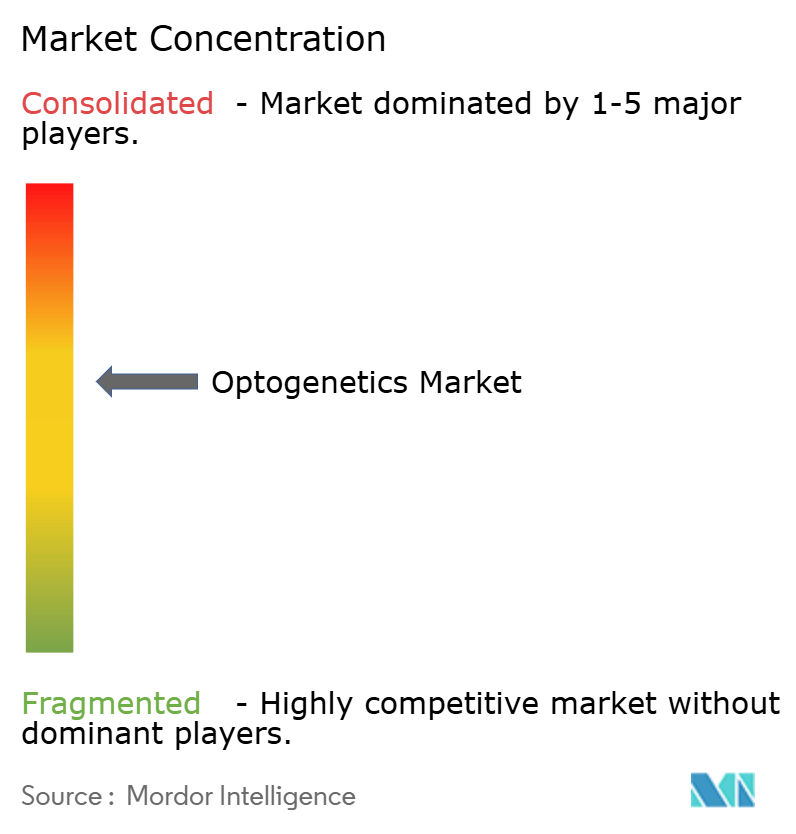
Optogenetics Market News
- June 2024: Researchers from the University of California, Los Angeles (UCLA) in the United States collaborated with the Federal University of the ABC in Brazil to stimulate the neural circuit through optogenetics. In this experiment, the neurons were made sensitive to light, which can manipulate the activity of brain cells. This experiment can relate brain functioning to eating.
- May 2024: Researchers at Duke NUS Medical School, Singapore, developed light-controlled brain cells that switch light-sensitive proteins. These cells provide an innovative tool for scientists to investigate brain functions. This opens various opportunities to incorporate optogenetics to identify different brain activities caused by neurodegenerative and psychiatric disorders such as Parkinson's disease and depression.
Optogenetics Market Report - Table of Contents
1. INTRODUCTION
- 1.1 Study Assumptions and Market Definition
- 1.2 Scope of the Study
2. RESEARCH METHODOLOGY
3. EXECUTIVE SUMMARY
4. MARKET DYNAMICS
-
4.1 Market Drivers
- 4.1.1 Potential Diagnostic Tool in the Field of Neurosciences
- 4.1.2 Rapid Growth of Advanced Technology
- 4.1.3 Increasing Use of Multimodal Imaging
-
4.2 Market Restraints
- 4.2.1 High Cost of Technology
- 4.2.2 Lack of Awareness
-
4.3 Porter's Five Forces Analysis
- 4.3.1 Threat of New Entrants
- 4.3.2 Bargaining Power of Buyers/Consumers
- 4.3.3 Bargaining Power of Suppliers
- 4.3.4 Threat of Substitute Products
- 4.3.5 Intensity of Competitive Rivalry
5. MARKET SEGMENTATION (Market Size by Value - USD)
-
5.1 By Light Equipment
- 5.1.1 Laser
- 5.1.2 Light-emitting Diode (LED)
-
5.2 By Actuator
- 5.2.1 Channelrhodopsin
- 5.2.2 Halorhodopsin
- 5.2.3 Archaerhodopsin
-
5.3 By Sensor
- 5.3.1 Calcium (Aequorin, Cameleon, and Other Calcium Sensors)
- 5.3.2 Chloride (Clomeleon)
- 5.3.3 Membrane-gated (Mermaid)
- 5.3.4 Other Sensors
-
5.4 By Application
- 5.4.1 Neuroscience
- 5.4.2 Behavioral Tracking
- 5.4.3 Retinal Disease Treatment
- 5.4.4 Other Applications
-
5.5 By Geography
- 5.5.1 North America
- 5.5.1.1 United States
- 5.5.1.2 Canada
- 5.5.1.3 Mexico
- 5.5.2 Europe
- 5.5.2.1 Germany
- 5.5.2.2 United Kingdom
- 5.5.2.3 France
- 5.5.2.4 Italy
- 5.5.2.5 Spain
- 5.5.2.6 Rest of Europe
- 5.5.3 Asia-Pacific
- 5.5.3.1 China
- 5.5.3.2 Japan
- 5.5.3.3 India
- 5.5.3.4 Australia
- 5.5.3.5 South Korea
- 5.5.3.6 Rest of Asia-Pacific
- 5.5.4 Middle East and Africa
- 5.5.4.1 GCC
- 5.5.4.2 South Africa
- 5.5.4.3 Rest of Middle East and Africa
- 5.5.5 South America
- 5.5.5.1 Brazil
- 5.5.5.2 Argentina
- 5.5.5.3 Rest of South America
6. COMPETITIVE LANDSCAPE
-
6.1 Company Profiles
- 6.1.1 Hubner Group (Cobolt Inc.)
- 6.1.2 Coherent Inc.
- 6.1.3 Gensight Biologics
- 6.1.4 Laserglow Technologies
- 6.1.5 Noldus Information Technology
- 6.1.6 Judges Scientific PLC (Scientifica)
- 6.1.7 Shanghai Laser & Optics Century Co. Ltd
- 6.1.8 Bruker Corporation
- 6.1.9 Thorlabs Inc.
- *List Not Exhaustive
7. MARKET OPPORTUNITIES AND FUTURE TRENDS
Optogenetics Industry Segmentation
As per the report's scope, optogenetics refers to a range of optical techniques used to elicit a physiological response in targeted biological systems without pharmacology and electric stimulations. Optogenetics controls neural activity by combining genetic engineering and optical tools. It is widely used in neuroscience for the modulation of neural circuits with high precision and specificity.
The optogenetics market is segmented by light equipment, actuator, sensor, application, and geography. By light equipment, the market is segmented into laser and light-emitting diodes. By actuator, the market is segmented into channelrhodopsin, halorhodopsin, and archaerhodopsin. By sensor, the market is segmented into calcium (aequorin, cameleon, and other calcium sensors), chloride (clomeleon), membrane-gated (mermaid), and other sensors. Other sensors include neurotransmitter sensors, pH sensors, and redox and metabolic sensors, among others. By application, the market is segmented into neuroscience, behavioral tracking, retinal disease treatment, and other applications. Other applications include cardiology, cellular and molecular biology, and pain research, among others. By geography, the market is segmented into North America, Europe, Asia-Pacific, Middle East and Africa, and South America. For each segment, the market size is provided in terms of USD value.
| By Light Equipment | Laser | ||
| Light-emitting Diode (LED) | |||
| By Actuator | Channelrhodopsin | ||
| Halorhodopsin | |||
| Archaerhodopsin | |||
| By Sensor | Calcium (Aequorin, Cameleon, and Other Calcium Sensors) | ||
| Chloride (Clomeleon) | |||
| Membrane-gated (Mermaid) | |||
| Other Sensors | |||
| By Application | Neuroscience | ||
| Behavioral Tracking | |||
| Retinal Disease Treatment | |||
| Other Applications | |||
| By Geography | North America | United States | |
| Canada | |||
| Mexico | |||
| Europe | Germany | ||
| United Kingdom | |||
| France | |||
| Italy | |||
| Spain | |||
| Rest of Europe | |||
| Asia-Pacific | China | ||
| Japan | |||
| India | |||
| Australia | |||
| South Korea | |||
| Rest of Asia-Pacific | |||
| Middle East and Africa | GCC | ||
| South Africa | |||
| Rest of Middle East and Africa | |||
| South America | Brazil | ||
| Argentina | |||
| Rest of South America | |||
Optogenetics Market Research FAQs
How big is the Optogenetics Market?
The Optogenetics Market size is expected to reach USD 600.20 million in 2025 and grow at a CAGR of 4.29% to reach USD 740.48 million by 2030.
What is the current Optogenetics Market size?
In 2025, the Optogenetics Market size is expected to reach USD 600.20 million.
Who are the key players in Optogenetics Market?
Laserglow Technologies, Coherent Inc., Thorlabs Inc., Gensight Biologics and Noldus Information Technology are the major companies operating in the Optogenetics Market.
Which is the fastest growing region in Optogenetics Market?
Asia Pacific is estimated to grow at the highest CAGR over the forecast period (2025-2030).
Which region has the biggest share in Optogenetics Market?
In 2025, the North America accounts for the largest market share in Optogenetics Market.
What years does this Optogenetics Market cover, and what was the market size in 2024?
In 2024, the Optogenetics Market size was estimated at USD 574.45 million. The report covers the Optogenetics Market historical market size for years: 2019, 2020, 2021, 2022, 2023 and 2024. The report also forecasts the Optogenetics Market size for years: 2025, 2026, 2027, 2028, 2029 and 2030.
Our Best Selling Reports
Optogenetics Market Research
Mordor Intelligence provides a comprehensive analysis of the optogenetics market, drawing on our extensive experience in life sciences research and consulting. Our latest report examines the rapidly evolving landscape of optogenetic technology. It offers detailed insights into this revolutionary field. The analysis covers cutting-edge developments in optogenetics, including advanced research applications, emerging therapeutic approaches, and innovative instrumentation solutions. Our report PDF is available for immediate download, offering stakeholders a thorough understanding of market dynamics and growth opportunities.
The report delivers valuable insights for optogenetics companies and industry stakeholders. It features detailed profiles of key market players and their strategic initiatives. Our analysis includes precise market size projections, assessments of technological advancements, and evaluations of the regulatory landscape. Stakeholders benefit from our detailed examination of research infrastructure development, funding patterns, and commercial applications of optogenetic solutions. The report's comprehensive coverage helps organizations make informed decisions about investments, partnerships, and strategic planning in this transformative field.

